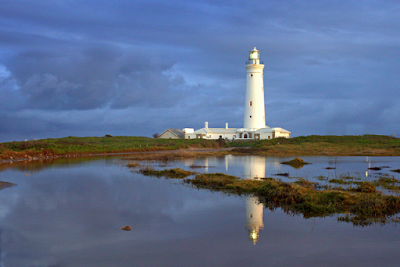Cape Vidal:
South African Lighthouse No. 7
 |
| Photo Credit: Don Brotherston Photography |
When I started this week's search, I had no clue as to what the Cape Vidal lighthouse even looks like. Then, as soon as I laid eyes on it, it was crystal clear that its appearance is quite unique in a very obvious way:
It is painted bright yellow!
It was constructed in 1985, so it's still a youngster in the lighthouse community. The youngest in South Africa, actually.
According to Lighthouses.co.za, it is also said by some that the lighthouse watches over the ill-fated ship 'Dorothea'. Trying to find out a bit more about the 'Dorothea', I inadvertently stumbled upon a bit of mystery - and tales of rumoured treasure:
"It is almost certain that the American iron barque Dorothea, which drifted
 |
| Image Credit: Fred |
Nobody has cleared up the mystery of the gold*, valued at the time at R1m, wich she was supposed to have been carrying in her hold.
It is believed that the gold was stolen from the Rand** mines and shipped at Delagoa Bay one jump ahead of the police, who were trailing the gold thieves.
The gold, amounting to 120 000 oz, is said to have been in twelve boxes and three leather bags at the foot of the foremast, covered with 25cm of cement.
Various efforts to salvage the gold have failed, some with loss of life."
(Acestors SA)
*Also see Kruger millions
**Witwatersrand, Johannesburg
I even found this article from Page 7 of the Cairns Morning Post, Monday, 19 April 1909:
Kruger's Gold Story
a Myth
The first full and complete story of the gold that was smuggled, out of the Transvaal just before the Boer war has just come to light from the diary of Colonel Clarke, now Chief Commissioner of the Natal Police, and formerly head of the Criminal Investigation Department of the Colony. From this it appears that 'Kruger's gold is a myth and that the smugglers were a syndicate of illicit gold buyers who were plundering the Transvaal gold mines.
The value of the gold is estimated at from £600 000 to £1 000 000, and search for it is now being made off Cape Vidal, St Lucia Bay, Zululand. The gold, according to the diary, was put on board the barque Dorothea at Delagoa Bay. It was in January 1898, that the vessel set sail, but she was wrecked the day after her departure.
The gold, it is said, was put on the vessel before the captain and crew engaged for the journey went aboard. The treasure was securely held [?], and then covered with ballast. The vessel was well out to sea when the strain of the sails caused an opening of the seams (the vessel was a wooden one), and the ship took in water.
Fearing that there was a danger of the vessel foundering, the captain hailed a Union steamship which was passing and asked the captain of it if he would tow the Dorothea back to Delagoa Bay. The Union boat signalled that she was tied to time and could not tow the vessel, but the captain was willing to take off the Dorothea's crew. As there would be too much difficulty in attempting to get the ballast on, and as there was every indication that the vessel would founder, the captain decided to accept the offer of the Union captain. The crew of the Dorothea were taken over, and the vessel was abandoned.
The vessel went ashore at Cape Vidal and broke up. One side of the ship floated up the coast to a point fifteen miles distant, and on this portion of the vessel two expeditions have worked in the belief that it contained the gold. Colonel Clarke is convinced, however, from what he was told by the natives, who witnessed the wreck, and information obtained from other sources that the gold went to the bottom off Cape Vidal. In 1890 [?] Colonel Clarke carried out searching operations but it was necessary to wait for a calm day to permit of a diver ...ted [?] itself, and on that occasion another boat appeared off the coast and the search was postponed. Subsequently other duties compelled Clarke to leave the spot.
A syndicate has been formed at Johannesburg with a capital of £3 000 is now protecting the wreck off Cape Vidal. The expedition has a concession from the Natal Government for a period of one year and until that period expires no other person will be allowed to ...[?]
 |
| The Original Article |


Comments
Post a Comment